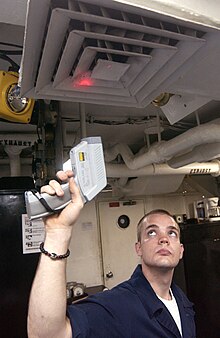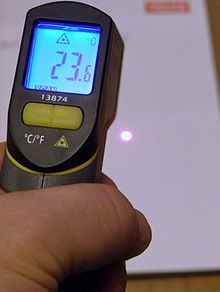pyrometer
Pyrometers (from ancient Greek πῦρ pyr , German 'fire' ), also called radiation thermometers , are used for non-contact temperature measurement . Temperatures between −50 ° C and +3000 ° C can be measured with such devices.
inventor
The real inventor of the pyrometer is difficult to determine. Pieter van Musschenbroek and Josiah Wedgwood probably both invented something that they and other scientists of their time called pyrometers, but these devices cannot be compared with modern pyrometers. The Encyclopædia Britannica names William Chandler Roberts-Austen as the inventor of the pyrometer.
Basics
Every object with a temperature greater than 0 Kelvin emits thermal radiation , the intensity and position of the emission maximum depending on its temperature . This radiation is recorded and evaluated with the pyrometer. If the measuring object is colder than the pyrometer, the radiation flux is negative, i.e. H. the pyrometer emits thermal radiation to the measurement object (which can be traced back to the 2nd law of thermodynamics ), which can also be evaluated.
The basis is the Stefan-Boltzmann law , according to which the total radiation power P for an ideal black body depends on the absolute temperature T (in K) and the area A (in m²). With the Stefan-Boltzmann constant = 5.6704 · 10 −8 W m −2 K −4 :
- .
Real bodies, also called gray bodies , emit an intensity that is one factor lower:
- .
For a non-contact temperature measurement, one has to know the emissivity , i.e. the heat radiation capacity of the measuring object.
Pyrometer types
In a ratio pyrometer (also called ratio pyrometer or 2-color pyrometer) the intensity (energy quantity) is not measured in just one wavelength range, but the ratio of the intensities for two different "colors" is formed. This means that the temperature is not determined based on the brightness , but based on the color of the radiation. With this method, the emissivity does not play a role in the formation of the ratio (shortening in the division) for the measurement, if it is not strongly dependent on the wavelength for the material being measured. The display shows the average temperature in the measuring field.
Pyrometers sometimes only evaluate a small part of the radiation spectrum that is restricted to a certain wavelength range by a filter . They are called narrow-band pyrometers - signal evaluation becomes easier, since the spectral sensitivity curve of the sensor only plays a negligible role here.
If the wavelength range is wider, it is called a band radiation pyrometer .
A total radiation pyrometer is a device that records the radiation of a measuring surface over the entire spectral range. However, since the lenses, windows and radiation receivers belonging to the pyrometer only work in a limited range of wavelengths, strictly speaking there are no total radiation pyrometers, but only ribbon radiation pyrometers. However, it has become an agreement to speak of total radiation pyrometers even if at least 90% of the radiation possible at a certain temperature is evaluated.
There is a visual procedure for glowing objects in which the incandescent light of a tungsten strip lamp ( incandescent lamp with tungsten tape instead of a filament) is brought into line with the object to be measured. You can now change the current of the lamp until its image disappears in front of the measuring object - then the strip temperature is the same as that of the measuring object. The adjustment knob for the lamp current has a temperature scale to read off the temperature. Such a measuring device is known as a filament pyrometer and belongs to the group of comparison pyrometers .
Measuring wavelength
Which range is optimal for the desired measurement depends on the material to be measured and its temperature.
For temperatures around room temperature, wavelengths in the middle infrared (MIR) come into question. Thermal and pyroelectric sensors are used.
Temperatures from approx. 50 ° C can be determined in the near infrared with IR photodiodes. So has a germanium photodiode z. B. a maximum reception wavelength of about 1.9 microns. The more suitable material InGaAs can be manufactured for maximum reception wavelengths of 1.9 to 2.6 µm, depending on the composition.
Temperatures from around 700 ° C can be measured with silicon photodiodes (maximum reception wavelength around 0.9 to 1.1 µm) or with comparison methods in the visible spectral range.
At the maximum reception wavelength of silicon photodiodes (1.1 µm), a body with a temperature of 3000 K has its radiation maximum, with silicon photodiodes, however, all temperatures above about 600 ° C can be measured. Since the emissivity of metals increases with decreasing wavelength, it makes sense to measure metals and metal melts at temperatures above approx. 1000 ° C with silicon detectors that are filtered to wavelengths between 0.5 and 0.7 µm. In general, the temperature measuring range of a pyrometer is much easier to expand upwards than downwards, since the radiation power increases at all wavelengths with increasing temperature .
The reception wavelength range of high temperature pyrometers is usually determined by the photo receiver used and the upstream optical filter.
Emissivity correction
The emissivity of the material must be known for a measurement using a pyrometer. In general, this depends not only on the material of the measurement object, but also on the wavelength (the reception wavelength range of the pyrometer used) and therefore the temperature of the object.
While most organic materials (wood, plastic, paper, paint) and ceramics have very high emissivities (around 0.95) in the medium (MIR) and far infrared (FIR), bare metals emit better at short wavelengths (violet end of the visible Spectral range) and have significantly lower emissivities in the near (NIR) and mid-infrared (MIR) and therefore less favorable emissivities for the measurement (polished gold in the MIR range e.g. only approx. 0.02).
If, however, metal z. B. anodized (aluminum) or heavily oxidized, it has a significantly higher emissivity of 0.9 in the MIR. Even with painted metals (any color!), The significantly higher emissivity of the paint is then decisive for the temperature measurement.
Pyrometers therefore often have a correction option for the emissivity, e.g. B. a rotary knob (potentiometer) with a scale from 0… 1. Some hand-held pyrometers ("infrared thermometers") also have an additional measuring input for a contact temperature sensor (e.g. a thermocouple ). To calibrate the pyrometer for an unknown material, ie to determine the emissivity, the temperature can first be measured with this additional sensor; the setting for the emissivity on the pyrometer is then adjusted until the non-contact measurement leads to the same result as that with the contact sensor.
Detectors
Thermal detectors (e.g. bolometers , pyroelectric sensors or thermopiles made from thermocouples ) or photoelectric detectors (uncooled or cooled photodiodes ) or lead salt photoresistors (PbS or PbSe) are used as detectors for pyrometers . The disadvantage of the pyroelectric and lead salt detectors is that they only work stably in alternating light. To do this, you need an optical modulator (chopper wheel) which, together with its motor, is a wear part.
The lens or window for devices in the near infrared range consists of glass or quartz glass, which is only permeable to radiation in the visible to the near infrared range up to approx. 4 µm. In the middle and far IR, the devices are windowless, or the lenses or windows consist of crystals such as germanium, silicon, CaF 2 , ZnS, ZnSe, KRS5 or also made of polyethylene (PE) or polypropylene (PP). The latter allow wavelengths up to about 20 µm to be recorded.
Advantages of non-contact temperature measurement
- very fast measurement (<1 s to less than 1 µs, depending on the device)
- very long, continuous measuring ranges possible (e.g. 350 ... 3000 ° C)
- No wear
- very little temperature influence on the measuring object
- no error due to poor thermal contact
- no mechanical damage to sensitive objects such as foils or paper
- no problem with moving objects to be measured
- Possibility of measuring even with high voltages , electromagnetic fields or aggressive materials
Disadvantages of non-contact temperature measurement
- The emissivity must be known for material, wavelength and temperature. A quotient pyrometer (see above) can help here if the ratio of the emissivities of the two measurement wavelengths does not change during the observable thermal process.
- Particularly in the case of metals, strong emissivity variations make precise measurements difficult (e.g. copper: 0.012 (polished, 327 ° C), 0.78 (strongly oxidized, 25 ° C), 0.91 (strongly oxidized, 527 ° C) ).
- Reflections from thermal radiation sources or light from the environment can influence the measurement result, particularly near the start of the measuring range. Remedy: Select a device with a higher measurement wavelength.
See also
- Thermography cameras are basically spatially resolving pyrometers.
- Bolometer
- Flow measurement technology
- Thermopiles
Web links
Individual evidence
- ↑ Johann Samuel Traugott Gehler ( Memento of the original from April 13, 2014 in the Internet Archive ) Info: The archive link was inserted automatically and has not yet been checked. Please check the original and archive link according to the instructions and then remove this notice. Physical dictionary
- ^ William-Chandler-Roberts-Austen. Encyclopaedia Britannica, accessed September 6, 2018 .
- ↑ Gruner: Basics of non-contact temperature measurement “radiation thermometry”. Retrieved April 20, 2020 .
- ↑ http://sales.hamamatsu.com/en/products/solid-state-division/ingaas-pin-photodiodes/long-wavelength-type.php InGaAs photodiodes from Hamamatsu
- ↑ Jörg Böttcher: Online Compendium Measurement Technology and Sensor Technology: Pyrometer. Retrieved October 4, 2019 .
- ↑ Sensortherm product data sheet . Retrieved September 18, 2018







